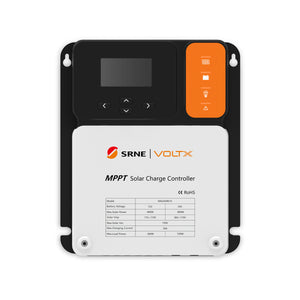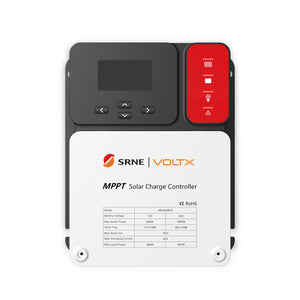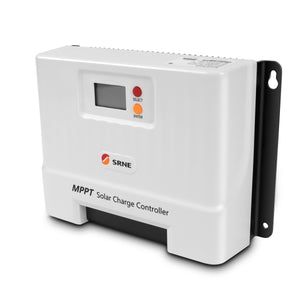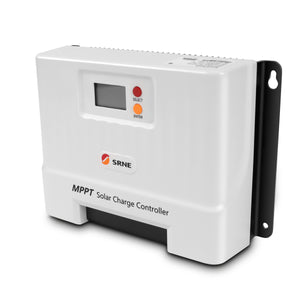VoltX SRNE 12V/24V 30A MPPT Solar Charge Controller
Was$169.99Now $135.99Unit price /UnavailableVoltX SRNE 12V/24V 60A MPPT Solar Charge Controller
Was$299.99Now $239.99Unit price /UnavailableVoltX SRNE 12V/24V 40A MPPT Solar Charge Controller
Was$159.99Now $127.99Unit price /Unavailable
Everything You Need to Know About MPPT Solar Charge Controllers
An MPPT solar charge controller serves as the intelligent interface between your solar panels and batteries, optimising energy harvest whilst protecting your power system's longevity. In Australian applications ranging from caravans and camping setups to comprehensive off-grid systems, these sophisticated devices have become essential components for anyone serious about solar energy. Maximum Power Point Tracking (MPPT) technology represents a significant advancement over traditional PWM controllers, continuously adjusting electrical parameters to extract the maximum available power from your solar panels regardless of weather conditions or temperature fluctuations.
As a solar charge controller, it not only manages the charging process but also safeguards your batteries from overcharging and damage, making it an indispensable charge controller for solar panels in any modern installation. Whether you're powering a weekend camping setup or designing a complete off grid system, understanding how these solar power battery chargers work can dramatically improve your system's efficiency and reliability.
How MPPT Technology Works
The brilliance of an MPPT controller lies in its ability to dynamically track and optimise the maximum power point of your solar panel array through sophisticated electronic algorithms. Solar panels produce varying combinations of voltage and current depending on sunlight intensity, temperature, and panel specifications, creating a constantly shifting power curve throughout the day. The controller continuously samples these parameters, calculating the exact voltage-current combination that yields the highest power output at any given moment, much like finding the perfect gear ratio on a bicycle for different terrain.
This intelligent tracking enables the MPPT controller to convert excess voltage into additional charging current, ensuring your batteries receive the maximum possible energy rather than wasting potential power as heat. Through rapid switching and conversion techniques, the controller maintains this optimal operating point even as environmental conditions change, typically adjusting hundreds of times per second to maintain peak efficiency.
Benefits of Using an MPPT Controller
The advantages of selecting an MPPT solar regulator extend far beyond simple efficiency gains, particularly when compared to PWM alternatives in the ongoing MPPT vs PWM debate. Research consistently demonstrates that MPPT controllers can harvest up to 30% more energy from the same solar array, with even greater gains in cooler weather when panel voltage naturally increases. This enhanced efficiency translates directly into faster battery charging times and potentially reduces the number of panels required for your system, offering significant cost savings over time.
Modern battery technologies, especially lithium iron phosphate (LiFePO4) batteries, particularly benefit from MPPT technology's precise charging algorithms, as an MPPT charge controller for lithium batteries can deliver the exact voltage and current profiles these advanced storage systems require. The sophisticated charging stages provided by a solar charge controller for LiFePO4 batteries ensure optimal battery health, extended lifespan, and maximum capacity utilisation, making MPPT controllers virtually essential for anyone investing in premium battery technology.
Choosing the Right MPPT Charge Controller
Selecting an appropriate MPPT charge controller requires careful consideration of your system's electrical parameters, including voltage compatibility, solar panel wattage, and the controller's amperage rating. Common configurations include 12V solar charge controllers and 24V options, with amperage ratings typically ranging from compact 20A MPPT solar charge controllers for smaller installations to robust 60A MPPT solar charge controllers for extensive arrays. A 12V MPPT solar charge controller might perfectly suit a caravan setup, whilst larger off-grid homes often require 40A MPPT solar charge controller or 60A variants to handle increased power generation.
Understanding how to size an MPPT controller involves calculating your solar array's maximum current output and adding a safety margin of approximately 25% to account for exceptional conditions and future expansion. The 30A MPPT solar charge controller represents a popular middle ground, offering sufficient capacity for most recreational applications whilst maintaining cost-effectiveness and compatibility with standard wiring and protection devices.
Getting Started with MPPT
Installation of an MPPT charge controller demands attention to safety protocols and manufacturer specifications, though the process remains accessible to those with basic electrical knowledge. Proper wire sizing, appropriate fusing or circuit breakers, and adequate ventilation form the foundation of a safe installation, whilst features like digital displays, USB ports, and remote monitoring capabilities enhance system oversight and convenience. Critical to performance is configuring the controller for your specific battery chemistry, particularly when using lithium batteries that require precise voltage parameters and charging profiles.
Many modern controllers offer pre-programmed settings for various battery types, simplifying setup whilst ensuring optimal charging performance. Professional consultation remains advisable for complex installations, though, or when uncertainty exists about system design. This is crucial because incorrect configuration can compromise both performance and safety, potentially damaging expensive components or creating hazardous conditions.
Making the Right Choice for Your Setup
Investing in a quality MPPT charge controller represents a commitment to maximising your solar system's efficiency and protecting your battery investment for years to come. Whether selecting a modest 20A controller for a weekend camping setup or a substantial 60A unit for comprehensive off-grid living, matching the controller's specifications to your panels and battery bank ensures optimal energy harvest from available sunlight. The superior performance of MPPT technology proves particularly valuable for maintaining battery health in lithium systems, where precise charging parameters directly impact longevity and capacity retention.
One such effective controller is the VoltX SRNE 12V/24V 30A MPPT Solar Charge Controller, which delivers high-performance solar energy regulation with a maximum panel input of 400W at 12V or 800W at 24V. With MPPT’s tracking efficiency at over 99% and a charging conversion efficiency of up to 98%, it ensures optimal energy harvest and battery charging. By understanding the technology's principles and carefully evaluating your system's requirements, you position yourself to harness maximum solar potential whilst safeguarding the substantial investment represented by modern battery banks and solar arrays.
Frequently Asked Questions
-
What is the main difference between MPPT and PWM charge controllers?
MPPT controllers actively track the optimal power point of solar panels and convert excess voltage to current, achieving 20-30% higher efficiency than PWM controllers, which simply connect panels directly to batteries without conversion.
-
Why is an MPPT controller better for charging lithium batteries?
MPPT controllers provide precise voltage and current control essential for lithium batteries' specific charging requirements, ensuring proper cell balancing and preventing damage from incorrect charging parameters.
-
How do I know what size MPPT controller I need for my solar panels and battery?
Calculate your solar array's maximum current output, then select a controller rated at least 25% higher to provide a safety margin and accommodate future expansion possibilities.
-
Can I use a 24V MPPT controller with a 12V battery bank?
Most quality MPPT controllers automatically detect battery voltage, but always verify the controller's specifications support both your panel and battery voltages before installation.
-
Do MPPT controllers work in all weather conditions?
MPPT controllers excel in all conditions, particularly in cold weather and partial shade, where their tracking algorithms maximise available power despite challenging circumstances.
-
What are the benefits of using an MPPT controller in cloudy weather?
MPPT technology extracts maximum power even from reduced light levels, maintaining higher efficiency than PWM controllers when panels operate below peak conditions.
-
Where should I mount my MPPT charge controller?
Install controllers in cool, dry, well-ventilated locations close to batteries to minimise voltage drop, avoiding direct sunlight and moisture exposure.
-
Do I need fuses or circuit breakers with an MPPT controller installation?
Yes, proper overcurrent protection on both solar and battery connections is essential for safety and typically required by electrical standards.
-
Can an MPPT controller overcharge my batteries?
Quality MPPT controllers feature multi-stage charging algorithms and temperature compensation, preventing overcharging while maximising battery capacity.
-
What maintenance is required for an MPPT charge controller?
Minimal maintenance involves periodic connection checks, ensuring adequate ventilation, and updating firmware when manufacturers release improvements.
-
Can I connect multiple solar panels to one MPPT controller?
Yes, panels can be connected in series or parallel configurations, provided total voltage and current remain within the controller's specifications.
-
How does temperature affect MPPT controller performance?
Controllers typically derate output at high temperatures for component protection, whilst cold conditions improve solar panel voltage and overall system efficiency.
Frequently Asked Questions
- What is the main difference between MPPT and PWM charge controllers?
- Why is an MPPT controller better for charging lithium batteries?
- Can I connect multiple solar panels to one MPPT controller?
- How does temperature affect MPPT controller performance?
- How do I know what size MPPT controller I need for my solar panels and battery?
- Can I use a 24V MPPT controller with a 12V battery bank?
- Do MPPT controllers work in all weather conditions?
- What are the benefits of using an MPPT controller in cloudy weather?
- Where should I mount my MPPT charge controller?
- Do I need fuses or circuit breakers with an MPPT controller installation?
- Can an MPPT controller overcharge my batteries?
- What maintenance is required for an MPPT charge controller?





